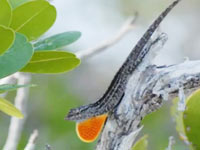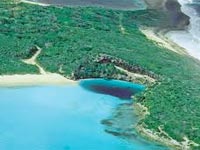
When hurricane Frances swept across the Bahamas nearly a decade ago, it wiped out all the lizards on scores of scrubby little islands, and gave a team of lizard-loving biologists a chance for a unique experiment in evolution.
The scientists, including a former postdoctoral fellow at UC Berkeley and a UC Davis professor, traveled to heavily forested Iron Cay, an island that was spared the hurricane’s worst effects, and collected lizard couples at random. They carried them to seven tiny treeless islands where no lizards remained, and on each island they released a single pair.
The biologists were testing a 70-year-old theory in evolutionary biology called the “founder effect,” which says that when a very small population “founds” a new and larger population of the same species, the founders’ genes will play a dominant evolutionary role in the new population for generation after generation.
On Iron Cay, the critters, called brown anole lizards (Anolis sagrei), long ago evolved long hind legs useful for running swiftly along broad tree branches to avoid predators. But on the seven islands slammed by Frances, the anole lizards that drowned had short hind legs, much better adapted to scurrying in and out of the short, tangled, scrubby bushes that thrive there.
If the founder effect held up, succeeding generations of the transplanted lizards would maintain their long hind legs, although the original lizard residents of the bush-covered islands had short legs.
So, every year for four years the scientists sailed back to the islands to observe and measure the legs on each new generation of the castaway couples’ descendants that were beginning to populate them.
After five or six generations, the founder effect appeared to be holding up, the scientists reported. Descendants of new lizard populations on the seven islands still show the long hind legs of their ancestors, the scientists say.
But another force of evolution also emerged – those long legs have been shortening year by year as each generation has begun adapting to the requirements of their new environment of scrub bushes.
Here was an example of Darwinian natural selection, the biologists noted.



